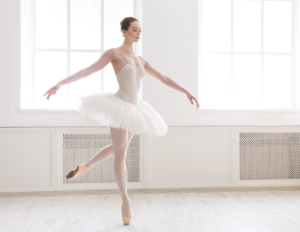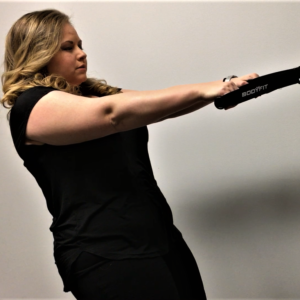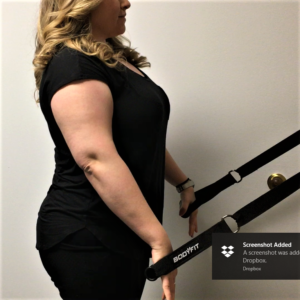Posts
Warm Up like the Australian Ballet!
/in The Performing Arts, Uncategorized /by Dr. Alyssa Arms, PT, DPT, OCSTrying to get your splits closer to the floor or your battements higher? Are you told to sit in front of the TV and stretch for long periods of time? It turns out that this may not be the best way to improve flexibility and performance while also preventing injury. The Australian Ballet agrees, and here’s why.
Static stretching may not always help and can cause harm.
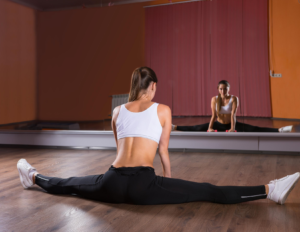
Dancers in the Australian Ballet were experiencing a lot of calf tears. Their physical therapists (PTs) wondered why this was the case. After changing their warm-up routine, the PTs found the culprit of these injuries to be static calf stretching.
What is static stretching? It’s when you hold a single position over a period of time, like this dancer sitting in her middle splits. For many years, it was thought that this was the best way to improve flexibility. But now that is changing. Besides, how often would you stay in a middle split while performing, auditioning, or competing?
The Australian Ballet used to do static calf stretching on a slanted board during warm-up for rehearsal or performances. Now, they’ve given their dancers a more dynamic form of calf stretching during warm-up. Because of this change, there was a significant decrease in calf tears within their company!
Strengthening muscle groups in a functional way is the key to success for dancers.
Dancers need a lot of strength when performing. This especially applies to something called “eccentric movements”. During an eccentric movement, the muscle is engaged but lengthening at the same time. For example, when a dancer performs a grand jeté, they use eccentric control of their calf when they land. Or when a dancer comes down from a relevé en pointe, they need good eccentric control to do it.
One way that the Australian Ballet works on this is by having thier dancers perform 24 one-leg heel raises at the end of each barre session, every day. As a result, they have seen a big decrease in ankle and calf injuries. These dancers may do thousands of single leg heel raises throughout a rehearsal or stage performance. By doing this set of heel raises at the end of barre, dancers’ muscles are primed for correctly using this motion throughout their rehearsal or performance. This ultimately decreases dancers’ risk for future injury.
Dancers must have the strength to perform powerful movements.
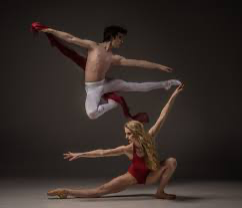
Besides switching from static stretches to more dynamic movement, the Australian Ballet also added a focus on strengthening deep core stabilizers and key power muscle groups. This has helped the dancers get their battements higher with more ease and prevent future injuries.
The deep core stabilizers protect the spine and provide stability of the torso. By activating these muscles, dancers won’t overcompensate with other muscle groups. Dancers can better protect their joints, muscles, and ligaments through using these deep muscles. Strengthening of the key muscle groups also gives dancers the power they need to do their amazing battements, turn sequences, and grand jetés.
Static stretching of these muscles for long periods of time can actually lead to them becoming inactive and less effective! We wouldn’t want dancers jumping into a rehearsal or performance with inactive muscles, since it could lead to significant injuries. So before dancing, dancers in the Australian Ballet activate their deep core and key power muscles. We call this “muscle priming”. Muscle priming wakes up key muscles that dancers need to give a beautiful performance while keeping them injury-free.
Our Recommendation
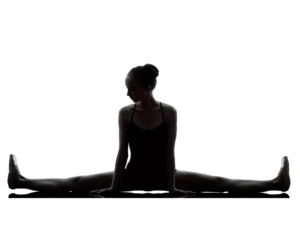
The dancers from companies like the Australian Ballet have seen the benefits of changing their warm-up routines, getting rid of static stretching and adding in muscle priming activities. And we agree with this concept! Dancers should do muscle activation exercises instead of static stretching or foam rolling before class, rehearsal, and a performance.
So next time you think about sitting in front of the TV in your middle splits, think again! Remember the importance of dynamic stretching, functional strengthening, and strengthening of certain muscle groups to ultimately improve your performance and keep you safe!
For more information on stretching, check out this link to our previous blog post. And if you’re looking for help to make these positive changes for yourself or your dance students, contact us. We love working with our dance community to keep everyone happy and healthy!
Also check our our Dancer’s Kit!
Click this link to check out the full article on why the Australian Ballet stopped stretching.
Guest blog by Marissa Holliday, student physical therapist.
Dancers’ Arm Movement & Shoulder Pain
/in Exercise Ideas, The Performing Arts, Uncategorized /by Dr. Alyssa Arms, PT, DPT, OCS The shaping and flow of the arms in dance helps to:
The shaping and flow of the arms in dance helps to:
- add complexity to lines of movement,
- communicate a story without words,
- contribute to both the beauty and strength of most styles of dance,
- and much more.
Because arm movement is so crucial to most styles of dance, we tend to do a LOT of repetitive movement, between practice and rehearsals, shows, performances, and competitions.
Think about your average ballet warm-up at the barre – during a plie combination alone, how many arm movements do you do?
In the classes that I took growing up, we probably did a minimum of 30-40 movements per arm just in that one section alone! Multiply that by the various aspects of a barre warm-up, working at center floor, time spent going across the floor, running choreography, and a cool-down. A single hour-long ballet class likely has hundreds of movements per arm.
How often have you felt like your shoulders and arms are getting tired during class? During rehearsal? During performances? Or maybe you’ve experienced pain in the shoulders as the muscles fatigue from all of the repetition and holding of positions?
I know that that was a reality for me sometimes. So what can you do about it? Luckily, the answer is easy – you have a lot of options!
But first, let’s talk about WHY this happens in the first place.
We have several muscles all around the u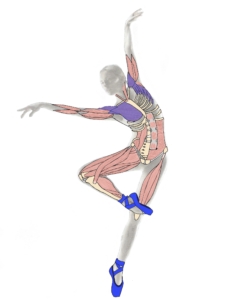 pper arm and torso that contribute to movement. These include muscles like the deltoids, biceps, triceps, latissimus dorsi, and several others. Possibly even more importantly, there are multiple muscles around the shoulder blades that play a key role in the movement and stability of the arms. The muscles around the shoulder blades are the rhomboids, trapezius, serratus anterior. There are also four muscles of the rotator cuff that are important – infraspinatus, supraspinatus, subscapularis, and teres minor.
pper arm and torso that contribute to movement. These include muscles like the deltoids, biceps, triceps, latissimus dorsi, and several others. Possibly even more importantly, there are multiple muscles around the shoulder blades that play a key role in the movement and stability of the arms. The muscles around the shoulder blades are the rhomboids, trapezius, serratus anterior. There are also four muscles of the rotator cuff that are important – infraspinatus, supraspinatus, subscapularis, and teres minor.
Here’s why the muscles around the shoulder blades are so important.
Think of it this way: when you’re building a house, the foundation needs to be strong and sturdy. If it’s not, then the house built on that foundation is liable to collapse. Those shoulder blade muscles are like the house foundation.
These muscles must be strong and working together in the appropriate ways. That way, when you are doing all of your different arm positions and movements, the arm itself doesn’t have to work so hard, strain is reduced, and things don’t fatigue as quickly. And, on the flip side, if those muscles around the shoulder blades don’t do their jobs correctly, the muscles of the arm have to work hard, meaning that it’s more likely to develop pain and fatigue.
So What Can You Do?
Like I said before, there are things that can be done to improve that foundation! The approach requires a combination of tactics, including mobility, stability, and strength, and working in that order is a great way to do it. Click each of the links to see the video of the exercise in action!
It’s important to know that the best plan of attack is customized for each person individually, but I still wanted to share some ideas for you to try.
Mobility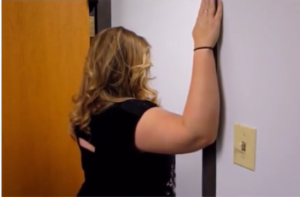
- Pec Stretch – This stretch is easy to do at any doorway or corner of the wall. It helps to stretch out the muscles at the front of the shoulders and chest, allowing you to open up the chest more easily while you do various arm movements and positions.
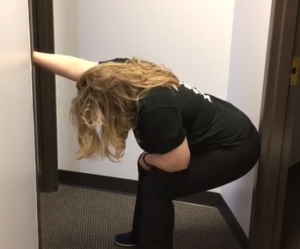
- Lat Stretch – If you ever have trouble keeping your arms overhead without arching your back, this is a great stretch for you! This targets all kinds of muscles around the trunk, ribs, and shoulder, helping with all kinds of things.
Stability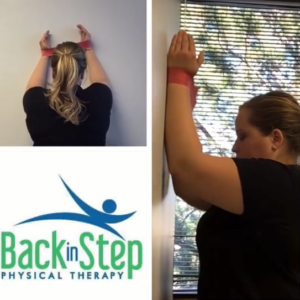
- Wall Crawls – All you need is a wall and a resistance band to strengthen some of the muscles around the shoulder and shoulder blade. It helps to build a strong foundation, making it easier to keep your arms strong and stable while you dance!
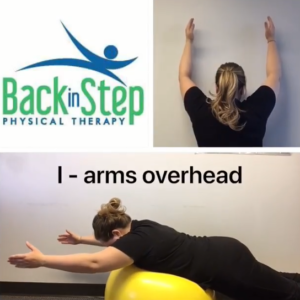
- I, Y, T’s – The wall crawls exercises focuses a bit more on the rotator cuff, whereas this group of exercises targets the stabilizers of the shoulder blade. Another great way to build a strong foundation.
Strength
- PNF D1 & D2 – This group of exercises builds upon the stability that you’ve gained with the previous exercises. Now, you are using more resistance and moving through larger motions. These exercises have a great connection to some of our dance technique, particularly if you’re doing something like partnering.
If you’ve tried these & still are having trouble with shoulder pain or controlling your arm movement, contact us to get an appointment & get checked out!
Also check our our Dancer’s Kit!
Rotator Cuff Strength is Important!
/in Exercise Ideas, Uncategorized /by Dr. Alyssa Arms, PT, DPT, OCSThe “rotator cuff” is something that a lot of people had heard of, but they’re not really familiar with what it actually does, why it’s important, etc. It’s also commonly called the wrong term – “rotator cup” or “rotary cup”, for example. The name tells you exactly what it does if you really think about it!
It’s a group of 4 muscles in the shoulder that surround the shoulder joint. Together, they provide the bulk of the stability for the shoulder itself, and surround most of the perimeter of the joint, much like any other type of cuff is used. For example, the cuff of a sleeve, handcuffs, and a blood pressure cuff surround another structure and provide some stability. This article will specifically talk about one of the muscles within this group – the infraspinatus.
The Anatomy & Function
The infraspinatus travels from the infraspinous fossa of the scapula (back of the shoulder blade) to the middle facet of the greater tubercle of the humerus (upper arm). It is one of the four rotator cuff muscles. Its innervation comes from the suprascapular nerve (C5-6).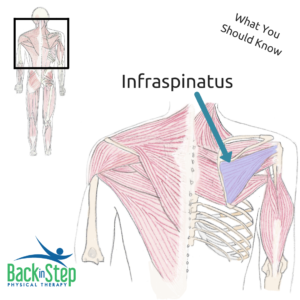
The infraspinatus helps with external rotation (turning your palm away from your body) of the shoulder and participates in abduction (moving your arm up from the side of your body). It also assists with stability of the shoulder joint and capsule.
A dysfunctional infraspinatus can contribute to arm or shoulder pain, upper back or shoulder blade pain, decreased range of motion and function of the arm. It can even be related to pain that travels through the arm, as far as the pinky finger.
What to Do About It
There are many ways to work on strengthening this muscle. This article describes an easier exercise to start with. We’re using a resistance band in this example, but this can also be done with a cable machine. You can use a free weight, but you then have to do this while lying on your side – otherwise, you’re not getting the right line of pull to be as effective.
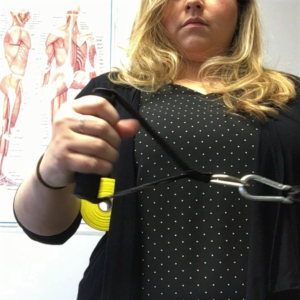
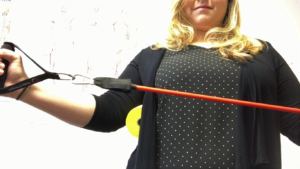
- Anchor the resistance band.
- Stand sideways to that anchor, with the band coming in front of your body.
- Keep your elbow bent at 90* and keep your elbow close in to your body.
- If you have trouble keeping it close to your body, put a small rolled up towel or other object between your arm and your body. If it drops, your elbow moved away from you.
- Keeping your thumb pointing up towards the ceiling, pull the band away from the anchor point.
- Only pull as far as you can comfortable go without twisting your body or shrugging your shoulder.
Give this exercise a try! If you’re experiencing any pain, hold off on doing the exercise and get in for an assessment with a physical therapist. You can contact us here for an appointment!
DISCLAIMER: The purpose of this site is to promote understanding of health, wellness, and prevention. The information on this site is not intended/implied to be a substitute for professional medical advice, diagnosis, or treatment. If you are experiencing pain, please see a medical professional.
Shoulder or Back Pain? Keep Reading!
/in Exercise Ideas, Uncategorized /by Dr. Alyssa Arms, PT, DPT, OCSWhen you’re experiencing pain in the shoulder or in the back, there are a lot of things that can be contributing to it. An evaluation with a physical therapist can help assess what all is playing a role in your pain. One structure that can be involved with BOTH areas is a large muscle called the latissimus dorsi.
The Anatomy & Function
The latissimus dorsi (lat) spans a large area across the back, originating from various points throughout the pelvis and low back (at the spinous processes of T7-L5, the thoracolumbar fascia, the iliac crest, and inferior 3-4 ribs). It then inserts at the intertubercular groove of the humerus (near the shoulder on the upper arm bone). It is the largest muscle in the upper body. The innervation is from the thoracodorsal nerve (C6-8).
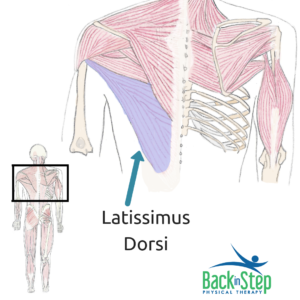
It helps in many different motions or actions, including shoulder extension (moving your arm behind you), shoulder adduction (bringing your arm across your body), and arm internal rotation (rotating your palm towards your body). The lat also assists with several other motions at the shoulder and helps to support and move at the spine.
If the latissimus dorsi isn’t doing its job, it can contribute to arm or shoulder pain, low back pain, decreased range of motion and function of the arm, and more. It can also make it difficult to pull something towards you. Lastly, it can also affect how you can do exercises like pull-ups, lat pull-downs, rows, and deadlifts.
What to Do About It⠀⠀⠀⠀⠀⠀⠀⠀
We’ve got a couple of options to share with you – both a stretch and a strengthening exercise.
Lat Stretch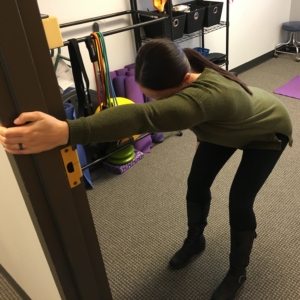
- Stand with your feet hip width apart or even slighty wider.
- Hold on to the door frame with your thumb pointing up towards the ceiling. Hand should start around chest height.
- Lean your hips back, like you’re trying to squat or sit back in a chair.
- To vary the stretch:
- Place your hand higher or lower on the door frame.
- Before sitting back into the stretch, rotate your body so that you’re facing your arm slightly, or so that your arm crosses slightly in front of your body. Then sit back.
Lat Strengthening
There are several different pieces of gym equipment that can be used for this exercise. However, one of my favorites is the TRX. It adds a dynamic balance component and works the core and hip stabilizers even more than some other options. Here’s how to do it:
- Stand with your feet shoulder width apart.
- Hold on to each of the TRX straps, arms in front of you and straight. Elbows do not need to be locked out in a straight position, however.
- Lean back, keeping your core engaged with spine and pelvis in neutral.
- Pull your hands down by your side, while keeping your body in this plank position.
- Make sure that you don’t let the shoulders hunch or roll forward as you come up to an upright position. Keep your shoulder blades pulled back and down to avoid this compensation!
Try these exercises and let us know how they work for you! They are two ways to try to combat shoulder or back pain. If you still have pain, give us a call and we can help get you back on track.
Do you have other things that you want to learn more about? Check out other blog posts and our Instagram page.
DISCLAIMER: The purpose of this site is to promote understanding of health, wellness, and prevention. The information on this site is not intended/implied to be a substitute for professional medical advice, diagnosis, or treatment. If you are experiencing pain, please see a medical professional.
Back In Step Physical Therapy
6551 S Revere Pkwy, Ste 215
Centennial, CO 80111
(303) 960-2075
info@backinsteppt.com

